Free and Easy in Greece in 2012
(Travel Story Series @ Hon Too Fang 2021)
My friends, we went to Greece in Sept/Oct 2012 and had a great time.
Why Greece
There are no "su-ka-bei-si" or "boss-punya" stories like going to Sulaweisi or Bosnia. This is straight forward. The Island of Santorini in Greece has been a dream destination for me for years. Then the delightful 2008 comedy "Mamma Mia" starring Meryl Streep and filmed on location in Greece added to the fascination.
But the decision to go came earlier this year. You see, there was this email posted to our class chat-group some months ago listing half a dozen "hanging" monasteries built high up on the mountain peaks, in Sikkim, China, Sri Lanka, Spain, etc. And topping the list are those in Kalambaka in Greece. I asked my classmate MP how many of these places he had visited. And his reply: all of them. I thought, wow, surely I must see one or two. Can't lose to MP by the score of 6 to zero. And wait any longer I won't be able to climb any peak. I am more kiasu than the Singaporeans. So Greece we went, together with PT and his wife. Self-planned.
Greece
Greece was the cradle of the Western civilsation, the birthplace of democracy, Western philosophy, and the Olympic Games. An old country, rather small, 40% of Malaysia in size, with about 10 million prideful people, predominantly Eastern Orthodox Christians. The people are very friendly. Before the present financial crisis the Greek workforce was rated as posting the 3rd most working hours a week in the European Union. The Greek are not as lazy. But the administration was corrupt and very inefficient, hence the sorry state of the financial affairs. The main industry is services, like tourism and shipping.
The Greek language uses a different set of alphabets unlike the English (which is Latin based): α, β, γ, ε, π, φ, etc. Like a revision of algebra signs! Many repeating vowels. In Athens, we stayed on this Aiolou Street. A-I-O-L-O-U, 5 vowels out of 6 letters. If you have that 6 tiles in your scrabble hand, each vowel worth only a point, die lah. How to score points?
Athens: the tourist city
Athens is the main city and capital of the nation, with about 660,000 people. It is one of the oldest cities in the World, with 3,400 years of recorded history. A tourist city. Shown a street graffiti, tourist merchandise, the hotel where we stayed (Hotel Tempi) and the café area in the evening, all around the tourist streets at the city centre.
The most famous tourist sights are related to ancient history and the ruins. Many ruins will be presented. Hope they would not ruin your reading pleasure.
Athens: the ruins @ Acropolis
The most famous ruins is the Acropolis, built around 495 to 429 BC. It is an ancient citadel located on a rocky outcrop above the city and contains the remains of several ancient buildings of great architectural and historical significance.
Shown a shot from the south-west from below the recital and a distant night scene from the north. The place is on various restoration programs since 1975, cranes are everywhere. Shown an archaeologist at work and a hugh tourist at the entrance
The most famous building here is the Parthenon dedicated to the goddess Athena, part of it under restoration. The base of the platform is 69 m by 31 m, with 46 outer columns and 23 inner columns. It is considered the most important surviving structure of Classical Greece.
The decorative sculptures are high points of Greek art. The 2nd photo is selected to highlight the scale of the columns, comparing them to the workers. The last photo shows the most characteristic feature in the architecture and decoration of the temple: the bas-relief frieze running around the exterior of the walls.
(Note in 2021: The present phase of the restoration work of the Parthenon started in 1981 is still unfinished. They should have appointed the Chinese!)
The next is the Erechtheum, dedicated to both Athena and Poseidon, the God of the Sea, with 6 female figures on the Porch of the Maidens. The 3rd photo shows the ruins of the Propylaea, the monumental gateway to the Acropolis. Then a view of the city from the citadel, and details of the columns, of the Doric order with simple capitals. Each column has 20 flutes or shallow grooves running vertically down. They are supposed to be the best Doric columns used in the Classical Greece period.
Next is the Theatre of Herod Atticus, built by the Romans in 161 AD and was renovated in 1950 for use today for classical concerts, etc.
On another day we passed by the southern slope of the Acropolis. Shown the southern high walls of the Theatre of Herod Atticus and the ruins of the Theatre of Dionysious, built around 342 BC and later enlarged by the Romans for gladiator fights. Next is the Stoa of Eumenes, a long colonnade with a gallery of statues.
Athens: the ruins @ Temple of Olympian Zeus
The Temple of Olympian Zeus is dedicated to the king of the Olympian gods. Construction started in the 6th century BC and completed in the 2nd century AD when the Romans were in power. It was then the biggest temple in Greece. The columns are 17 m in height and 2 m in diameters. 21 of 108 still remain. One of them on the ground. These are Corinthian columns compared to the older Doric columns in the Parthenon.
Athens: the ruins @ Ancient Agora
Agora means public place in a Greek city, often the center of the athletic, artistic, business, social, spiritual and political life in the city. This one in Athens is the best example of an ancient Greek agora. It is a huge place with most of the buildings in ruins. The Church of the Holy Apostles, 1st photo, is still quite intact though. The 2nd photo shows the gallery of statues along the entrance to the Odeon of Agrippa.
Another building in good shape is the the Temple of Hephaestus. From the 7th century until 1834, it was used as a church. The building's condition has been maintained due to its history of varied use.
The Stoa of Attalos was a covered walkway, 115 m by 20 m, built between 159 BC and 138 BC. It was rebuilt in 1952 – 56 and now houses the Museum of Ancient Agora. Shown an artistic shot of line, light and shadow. The 2 ceramic pieces are dated to the 15th century, BC. The casserole is dated to the 5th century BC.
Athens: the ruins @ Roman Agora
East of the Ancient Agora is the Roman Agora, a newer place of course. Two significant monuments are the Gate of Athena Archegetis built in 11 AD, and the Tower of the Winds which is a metrological station featuring a combination of sundials, a water clock, and a wind vane.
Athens: 2 churches
Over 80% of the people are Eastern Orthodox Christians. Very near to our hotel are several churches. A new one is the Metropolitan Cathedral completed in 1862. Shown the main entrance and some interior decorations. And within sight of the Cathedral is a small old church, the Church of Eleutherios built in the 14th century.
Athens: the Olympic game
Greece is home to the Olympic Game. Shown below is a view of the Panathenaic Stadium used to host the First modern Olympic Game in 1896. Seating capacity: 45,000. All white marble seats. Your living room all imported marble floor eh? For 4 people? Nothing lah compared to this! This one for 45,000 people! So don't need to boast lah. Today the field itself is considered too small for football games and modern athletic meets. It became a white elephant, with its white marble. What a waste!
Greece also hosted the 2004 Olympic Games. And it was the heavy borrowing to fund this 2004 Olympic Games that started the national debt which later spiralled out of control.
Athens: the National Archaeological Museum
Established in 1829, it is one of the greatest museums in the world and contains the richest collection of artefacts from Greek antiquity worldwide. Shown 2 of the exhibits from the Egyptian Collections.
The collection of sculptures is huge. Shown are 2 bronze pieces: Emperor Augustus, 10 BC and the Marathon Boy, 330 BC. And 2 marble sculptures: Poseidon of Melos, 120 BC, and a female figure, 100 BC.
The section on vase is impressive. Many in numbers and in types. Shown here two painted vases, almost a meter tall, made around 750 BC, originally found in Athens. These are funerary monuments, the painting depicting mourning scenes. Imagine, such beauty made almost 2,770 years ago.
Athens: politics
The Presidential Palace is old, simple and look run down. Shown the central portal and the changing of guards.
Delphi: the half-way town
Our next must-see destination is Kalambaka to the north, but we have to break bus journey to stay 2 nights at this ancient town of Delhi, 120 km north-west of Athens. The ancient Greeks considered Delphi the centre of the world and the seat of Pythia, the major oracle who was consulted about important decisions throughout the ancient classical world.
The town has about 1,500 residents, perched on a slope 500 m above the valley floor. A scenic place. The streets are deserted though. At the time of our visit, Greece was at the peak of their financial crisis. And Delphi depends mainly on local tourists for business. The last photo shows the biggest building in town: their local church, a similarity in most small towns in Europe.
Delphi: pay homage to Apollo
In ancient times Delphi was a major site to worship Apollo. In Greek mythology Apollo is a "principal" god, the alpha in the pack. The big Delphi Sanctuary on a hill slope is a UNESCO World Heritage Site. It was built over a few centuries, and essentially destroyed by the Romans around 390 AD on religious ground. The Romans have become Christians by then.
The main temple is of course the Apollo Temple, this is the 3rd version, dates from the 4th century BC. The famous oracle, the Pythia, was supposed to operate inside the temple. Only a few columns at the south east corner remain.
Then the treasuries, buildings to house dedications and votive offerings made by the various city-states and citizens to the sanctuary of Apollo. Shown the Athenian Treasury and the Boeotian Treasury, both reconstructed.
At the mountain top is the Delphi Stadium which has seating capacity of 6,500 and a track of 177 m. Below the stadium is the Theatre, first built in the 4th century BC and could sit about 4,500 people.
There is a museum on site. Here are some notable exhibits: the Charioteer of Delhi, in bronze, 475 BC, Dancers of Delphi, 13 m tall, 370 BC, the Sphinx of Naxos, 560 BC and a sculpture overlaid with gold and ivory (called a chryselephantine sculpture)
550 BC.
Delphi: the Temple of Athena Pronasia
This temple is located about 1 km from the main Delphi Sanctuary. The present complex, built in the 4th century BC and in ruins, is the 3rd version of the temple. The most important of the ruins is the circular temple called the Tholos of Delphi. It has 20 external Doric columns, 3 still standing, and is dated to 380 BC.
In ancient time, Delphi was home to the Delphi Oracle, the greatest of all Greek oracles. The last photo shows a modern oracle at work at the shaded area within the ground of the Temple of Athena Pronaia. Overheard her saying in English, "This place has a tremendous energy level. You must think positive and all your dreams will be fulfilled...." Her words were translated to Greek to about 30 young people. She must be leading a motivation course. What special energy level? Or just to earn a living?

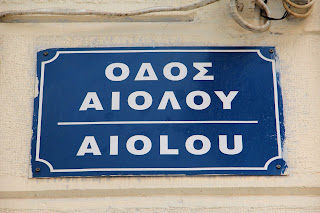
























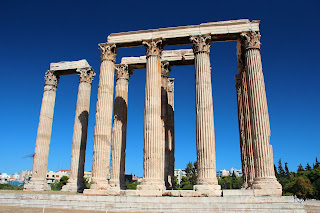


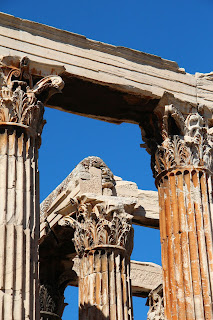






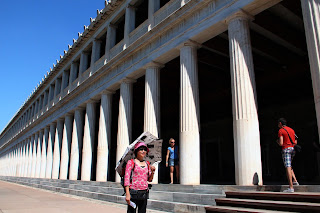

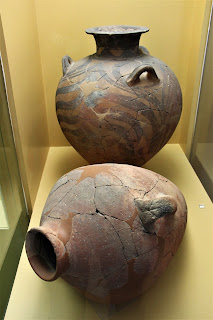




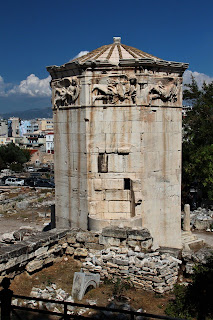




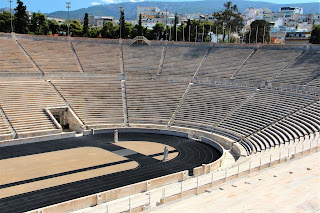




































No comments:
Post a Comment